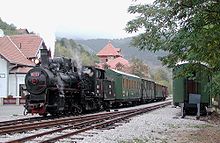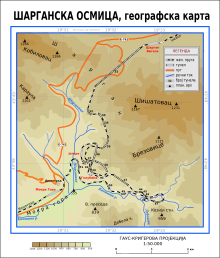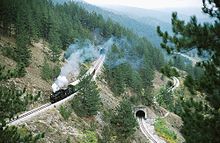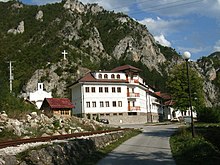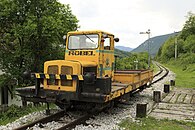Šarganska osmica
| Šarganska osmica | ||||||||||||||||||||||||||||||||||||||||||||||||||||||||||||||||||||||
|---|---|---|---|---|---|---|---|---|---|---|---|---|---|---|---|---|---|---|---|---|---|---|---|---|---|---|---|---|---|---|---|---|---|---|---|---|---|---|---|---|---|---|---|---|---|---|---|---|---|---|---|---|---|---|---|---|---|---|---|---|---|---|---|---|---|---|---|---|---|---|
| Gauge : | 760 mm ( Bosnian gauge ) | |||||||||||||||||||||||||||||||||||||||||||||||||||||||||||||||||||||
| Maximum slope : | 18 ‰ | |||||||||||||||||||||||||||||||||||||||||||||||||||||||||||||||||||||
| Minimum radius : | 120 m | |||||||||||||||||||||||||||||||||||||||||||||||||||||||||||||||||||||
| opening | January 25, 1925 (Užice – Vardište) | |||||||||||||||||||||||||||||||||||||||||||||||||||||||||||||||||||||
| Shutdown | February 28, 1974 (Užice – Višegrad) | |||||||||||||||||||||||||||||||||||||||||||||||||||||||||||||||||||||
| Recommissioning | August 30, 2003 (Šargan Vitasi – Mokra Gora) | |||||||||||||||||||||||||||||||||||||||||||||||||||||||||||||||||||||
| operator | Železnice Srbije | |||||||||||||||||||||||||||||||||||||||||||||||||||||||||||||||||||||
| Remarks | Distance kilometers according to the Belgrade – Sarajevo timetable around 1960 |
|||||||||||||||||||||||||||||||||||||||||||||||||||||||||||||||||||||
|
||||||||||||||||||||||||||||||||||||||||||||||||||||||||||||||||||||||
The Šarganska osmica is a narrow-gauge mountain railway in Bosnian gauge located in the west of Serbia , south of the Tara National Park . The continuation of the Bosnian Eastern Railway from Mokra Gora to Šargan Vitasi , which was closed in 1974 and located on Serbian territory, was rebuilt as a museum railway and tourist attraction from 1999 with Yugoslav government funds .
In German-language literature, this museum railway is also referred to as the Sargan Railway , meaning that the name “Sargan osmica” could best be translated as “Sargan eighth”.
history
Preliminary work
In July 1906, the Bosnian Eastern Railway from Sarajevo via Višegrad to the Serbian border was built under Austro-Hungarian administration and operated by the Bosnian-Herzegovinian State Railways. This stretch branched out between Ustiprača and Višegrad in two branches to Uvac and Dobrun . A continuation of the Dobrun route to Vardište was opened in August of the same year. This branch was subsequently operated as the main line of the Bosnian Eastern Railway. The 160 km long, elaborately laid out railway in a rugged mountain landscape was built for largely strategic considerations and could hardly be operated economically by the operator. Local passenger and freight traffic was of little importance in the sparsely populated area.
At the same time, several narrow-gauge railways with the same gauge were built in Serbia, but unlike in Bosnia-Herzegovina, they did not form a coherent network. One of these lines crossed central Serbia in the Western Morava Valley and ran from Stalac via Kraljevo and Čačak to Užice and had the character of a main railway. Another narrow-gauge railway ran from Mladenovac via Lajkovac to Valjevo and had a branch from Lajkovac to Obrenovac . Connecting routes from Lajkovac to Čačak and from Obrenovac to Belgrade were planned, and a merger with the Bosnian Eastern Railway west of Užice should enable continuous rail traffic between the Kingdom of Serbia and the Adriatic Sea .
After the occupation of Serbia in World War I , Austrian railway troops worked on building the line from Lajkovac to Čačak, and the connection between the Bosnian Eastern Railway and Serbia began in December 1915. For the latter project, the military administration set an unrealistically short time frame of just six to eight months. Starting from Vardište, the substructure up to the Mokra Gora area on Serbian territory was completed by 1916 with the workforce mainly Russian and Italian prisoners of war. There one faced the challenge of overcoming the Sargan Pass. At a distance of around three kilometers as the crow flies, a height difference of 240 m had to be overcome from the valley floor to the portal of the planned apex tunnel . When Romania entered the war in September 1916, however, the work was discontinued because the troops were urgently needed in other theaters of war. A tunnel collapse at the Budim tunnel with up to 200 rumored fatalities was not responsible for the termination of the work.
Construction and operation
The establishment of the Kingdom of Serbs, Croats and Slovenes after the end of the First World War required a series of rail projects that could be implemented quickly, and the connection between Serbia and Sarajevo and the Adriatic was seen as particularly urgent. In 1921, construction work on the route from Vardište over the Šargan Pass and further through the Đetinja gorge to Užice was resumed. Financial difficulties of the two companies commissioned with the construction led to delays in 1923 and the state to take over the work. After US loans had been granted, he was able to quickly complete the construction work, and public transport between Bosnia-Herzegovina and Užice began on January 25, 1925. With the completion of the Obrenovac – Belgrade railway line in October 1928, the more than 400 km long Belgrade – Sarajevo mainline was now continuously passable.
The Šargan mountain route was a central part of long-distance traffic within Yugoslavia. In addition to the express trains from Belgrade to Sarajevo, there were also continuous connections to Dubrovnik. These trains were equipped with dining and couchette cars and the journey time was 23 hours. The operation was carried out mainly with locomotives of the series 83 and 85 , 24 units of the series 83 were newly produced between 1924 and 1926 in the course of reparation deliveries. Before that, Mallett locomotives of the 92 series were also frequently used. From 1938 series 488 diesel railcars were available, which covered this tour in about 16 hours and 40 minutes. However, regional passenger transport was largely meaningless. Freight traffic was of particular importance, heavy freight trains from the Belgrade area and from Bor and Zaječar on the Bulgarian border crossed the Sargan in the direction of Bosnia-Herzegovina and the Adriatic Sea. A total of up to 40 trains drove daily on the route, which was in operation around the clock.
Decline and cessation
During the Second World War , the strategically important railway line was located in the center of the partisan- controlled Republic of Užice and became a target for combat operations. After the war damage was repaired after 1945, new standard gauge railways were built in Yugoslavia. From 1947, a faster and more powerful line from Belgrade to Sarajevo was available further north via Vrpolje and Brčko . Starting in 1960, the lines from Belgrade and the far east of Serbia were gradually converted to regular gauge, the narrow-gauge mainline ceased to exist after 32 years. The transition from the new standard to the narrow gauge took place in Čačak. In May 1969, the line from Čačak to Užice, now called Titovo Užice, was discontinued because it was to be converted to standard gauge as part of the new line from Belgrade to Bar, which was under construction . Titovo Užice thus became the end point of a branch line that only had to meet a comparatively modest transport requirement from Užice to Sarajevo. From then on, only three pairs of passenger trains ran across the Šargan in the direction of Višegrad and Sarajevo. Even after the opening of the standard-gauge railway to Titovo Užice in 1971, closing the gap did not bring any recovery in the number of passengers transported, so it was decided to discontinue the Titovo Užice – Višegrad section for economic reasons. On February 28, 1974, the last regular train ran over the Šargan mountain line. The Bosnian Eastern Railway from Sarajevo to Višegrad remained in operation for the time being and was discontinued as the last longer section of the Yugoslav narrow-gauge network on May 28, 1978. The tracks on the mountain route were only removed in 1989.
Lines
The steep ramp, which was reactivated as a museum railway until 2003, was planned and built in an elaborate loop development to increase the height, as a height difference of 240 m had to be overcome over a few kilometers as the crow flies. From the Mokra Gora train station, located at the bottom of the Šarganšica valley, the track initially runs a little further down the stream, starts a first loop at the head of the valley and, after the first tunnel, turns east towards the valley of the Kamišina stream. On the slope above the stream, the route quickly increases in height, at the end of this valley, the route partially turns 180 ° in a tunnel and now covers the entire route in the Kamišina valley in the opposite direction one level higher. The Golubići station, built as a film set, is located in this section. In an arc to the right, the train turns back towards the Šarganšica valley and reaches the Jatare station, originally designed only as a crossing point, at 701 m above sea level and just under a kilometer as the crow flies from the starting point. During the reconstruction, a restaurant was set up here, in keeping with the touristic character of the project, and a promenade path was laid up from the valley floor.
The route then changes direction again and traverses the slope behind the Jatare station in a longer tunnel. In doing so, it crosses twice under the next higher level of the route, which leads along the slope above Jatare after another change of direction. In this way, the railway line describes an eight, which is what gave the railway its name. Here, a viewing platform for the passengers of the tourist trains was built on the top level. After completing the figure eight, the route continues along the wooded slope, passes under the pass in the Šargan summit tunnel and ends after 15.3 km in the Šargan Vitasi train station. A locomotive hall with three tracks was built here as the operational center, and the track triangle for turning locomotives was also rebuilt.
The route has a constant gradient of 18 ‰ with a minimum radius of 120 m. 20 tunnels and five steel girder bridges will be crossed between Mokra Gora and Šargan Vitasi. The route that continued from Šargan Vitasi through the Đetinja valley to Užice, 35 km away and 400 m below, had a maximum gradient of 14.5 ‰.
Reconstruction as a museum railway
The interest in the narrow-gauge railway as a potential tourist attraction in the structurally weak region led to the first voluntary work assignments by railway enthusiasts and the town of Mokra Gora in 1997, and the following year the army carried out an evacuation operation on the railway line. In 1999 the project to rebuild the mountain route was officially approved by the Serbian Ministry of Tourism and funding was secured. The Ministry, the Belgrade Railway Museum and a planning institute in Belgrade developed a large-scale tourism concept with the narrow-gauge railway as the central element. Together with the nearby Tara National Park and the mineral springs of Mokra Gora, the border region threatened by rural exodus is to be economically revitalized by means of gentle tourism . The state railway operator Jugoslovenske Železnice was responsible for the construction and operation . Therefore, the Šargan Eight is an internationally rare instance of a state-funded museum and tourist railway, usually are in such orbits clubs the support of all activities. For the not inconsiderable investment in the reconstruction of a mountain section of a narrow-gauge railway that had been shut down for decades, it may also have been decisive that both the general director and another board member of the Yugoslav State Railways were particularly committed steam locomotive and railway enthusiasts during the initial phase of the project.
A first inspection showed a positive finding of the condition of the tunnels and bridges, so that the reconstruction could be started quickly. Used track material from stocks of the state railways was used for the construction. By the end of 2001, the upper section of the route from Šargan Vitasi to Jatare was open to traffic, the station area of Mokra Gora was restored and the station buildings restored or rebuilt. The first test drives and presentations were made with a class 83 locomotive. In the lower section in the vicinity of Mokra Gora there were delays because a mushroom cultivation first had to be moved out of a tunnel and the cemetery of Mokra Gora, which had been extended across the railway line, had to be relocated. These problems were resolved by summer 2003, and on August 30 of the same year the official inaugural train was able to take the entire mountain route from Mokra Gora to Šargan Vitasi. For the time being, scheduled traffic is operated with the diesel locomotives imported from Romania, the steam locomotives are used for tour groups to order and on special occasions. A visible difference to the earlier regular operation is the use of the compressed air brake instead of the previously common suction air brake .
The stations received mechanically set entry and entry pre-signals of old Austrian design. However, they are not used in regular operation with only one train unit. In the local area of Mokra Gora, two automatic crossing safety systems are in operation.
Extension and expansion plans
Right from the start of the project, the extension of the museum and tourist railway at both ends of the route was considered. Already with the first expansion stage, the line with the destination Višegrad in neighboring Bosnia and Herzegovina was rebuilt from Mokra Gora towards the border. This section, which leads through the narrow valley of the Rzav and connects the old border stations Vardište and Dobrun to the rail network, was largely completed by the end of 2006. In the end, only 1.7 km of the route in the local area of Višegrad and a suitable location for a train station were missing. The originally preserved Višegrad train station was used by a bus company as a bus station and was initially unavailable. In January 2008 it was announced that the city of Višegrad had budgeted the construction costs for the missing remaining section for 2008. On April 10, 2008 a report appeared about specific and quantified investment projects. Was mentioned u. a. the reconstruction of some bridges, the purchase of three steam locomotives and a turntable at the Višegrad train station. In June 2010, senior representatives of the Serbian State Railways orally stated that cross-border operations to Višegrad would start in the same year. In July 2010, the reconstruction work on the route began and tracks were laid. A media-staged and politically prominent opening took place on August 27, 2010 in the presence of Prime Minister Milorad Dodik and Serbia's President Boris Tadić . However, this act was not followed by any scheduled operation on the newly opened route. Since then, the Bosnian section has only been used occasionally for privately booked special trips by tour groups.
With this expansion, a section of the Bosnian Eastern Railway built by Austria-Hungary was put back into operation. A special feature is that this railway line is one of the very few cross-border museum and tourist railways in the world (like the Wachtl Express on a much smaller scale ). The border controls are carried out at a provisional stop at the border tunnel near Vardište. Along with the Banovići coal railway , the section in Bosnia is the only remaining part of the Yugoslavian narrow-gauge network with a gauge of 760 mm that existed in Bosnia and Herzegovina until around 1970.
In the long term, the Šarganska osmica is to be reactivated further in an easterly direction and to be connected to the Belgrade – Bar railway line . This expansion would make it possible to travel by rail in the future. Since parts of the old route west of Užice fell victim to a dam project in the Đetinja valley and are now under water, the reactivation of the original route would require extensive and costly re-routing. The Branešci railway station is therefore seen as an alternative connection point , approx. 12 km straight line distance from the former Kremna railway station. From Kremna, this would make it necessary to build a completely new narrow-gauge railway line that is shorter and less complex than the original route. A possible connection of the Užice airport to the narrow-gauge railway was already under discussion, but concrete plans were not yet presented for any variant. So far, the extension has been completed shortly before the former Kremna station. Since the station area has meanwhile been used for road construction, a solution for the construction of a station can still be found here.
The Šarganska Osmica was also supplemented by a short, newly built forest railway with a gauge of 600 mm, which leads from Mokra Gora to a picnic area in the Kamišina valley, but is currently not used.
Locomotives
Although there was little official interest in preserving vehicles in museums after the Yugoslav narrow-gauge railways were closed, some rolling stock was retained due to the large number of vehicles. Locomotives were erected as monuments, some of them declared as locomotives from dismantling trains that were left in place, and several machines were installed in the narrow-gauge railway museum in Požega , founded on a private initiative . From these stocks it was possible to get several steam locomotives for the Šarganska osmica, which are reconditioned and serviced in the Šinvoz repair shop in Zrenjanin, Serbia . Some L45H series diesel locomotives were acquired in Romania .
Steam locomotives
| Row / number | design type | Wheel alignment | Manufacturer / year of construction | Remarks |
|---|---|---|---|---|
| 25-27 | Industrial railway tank locomotive | C. | ČKD , 1949 | operational, led the mining trains in 1989 |
| 83-052 | Universal locomotive with a tender | D1'h2-t | Jung / Jungenthal , 1926 | previously a monument in Zaječar, operational |
| 83-173 | Universal locomotive with a tender | D1'h2-t | Đuro Đaković , 1949 | previously Museum Požega, operational |
| 85-005 | Express locomotive with a tender | 1'D1'h2-t | MÁVAG , 1930 | previously a memorial in Čačak, planned for processing |
| ELZA | Industrial railway tank locomotive | C. | operational, Zrenjanin sugar factory locomotive |
|
| UNRRA 22 | Tender locomotive | Dh2-t | Porter, 1945 | from US aid delivery, intended for processing |
| CFF 764-427 | Forest Railway Tender Locomotive | D. | Reșița , 1954 | Romanian forest railway locomotive, stationary memorial at Mokra Gora station |
| Forest railway tank locomotive, track width 600 mm | C. | Đuro Đaković, 1947 | operational, formerly Visnjicevo forest railway |
|
| 19-126 | Industrial locomotive (ex Maglic) | C. | Henschel , 19126/1923 | stationary monument at Dobrun train station (Bosnia-Herzegovina) |
Diesel locomotives
Four four-axle diesel locomotives of the L45H series acquired from Romania are used in everyday traffic . From 2004 the 720-003 diesel locomotive of Yugoslav origin was used for construction train services on the Bosnian-Herzegovinian section.
Train with Romanian L45H diesel locomotive in Šargan Vitasi.
Robel -Skl, converted from normal to narrow gauge.
Cultural references
The marketing of the railway as a tourist attraction also revived some episodes related to this railway that had found their way into local folklore.
In the 1970s, when the inexorable end of the Yugoslav narrow-gauge railways was looming, President Tito is said to have expressed the wish to preserve a narrow-gauge line for posterity. His choice is said to have fallen on the Šargan mountain route, on the one hand it was one of the most important transport structures of the unified Yugoslavia, on the other hand it also played a role in the partisan war. However, there is no evidence of such commitment by the head of state. An indication that the line was initially regarded as a kind of monument may be that the tracks were only dismantled 15 years after the cessation of operations in 1989, contrary to the usual practice of dismantling them soon after the closure.
The clairvoyant Mitar Tarabić from Kremna, who was revered as a kind of “Serbian Nostradamus ” and who made a series of prophecies in the 19th century that could be interpreted as visions of events of the 20th century, also told of an “iron path” that one crossed the Sargan Mountains would be built to transport people and goods with "fire carriages". According to Tarabić, however, this should be forgotten and rebuilt many years later for the pleasure of the people.
Also the director and filmmaker Emir Kusturica , who is very committed to the tourist development of the region and who built the town of Küstendorf on a hill west of Mokra Gora , has the Šarganska osmica in his film Život je cudo ( Life is a miracle ) a leading role send. The small Golubići station was specially built as a film set for this purpose.
literature
- Keith Chester: The Narrow Gauge Railways of Bosnia-Hercegovina . Stenvall Verlag, 2006, ISBN 91-7266-166-6
- Milan Grujić: Phoenix at Sargan - two lives of the Sargan railway line . Zelnid, Belgrade, 2006, ISBN 86-7307-187-9
- Johann Rihosek : The locomotives of the Bosnian-Herzegovinian state railways . Reprint 2005 [2]
- Werner Schiendl , Franz Gemeinböck: The railways in Bosnia and Herzegovina 1918–2016 . Edition Bahn im Film, Vienna 2017, ISBN 978-3-9503096-7-6 .
- Zoran Veresić: Steam in Serbia 1882–2007 , Royal Railway Society of Serbia, Belgrade, 2007
Web links
- Official information page of the Serbian Railways
- Hungarian website about the Šarganska osmica with numerous pictures
- Railway map of Serbia
- Railway map of Bosnia and Herzegovina
Individual evidence
- ↑ a b Schiendl, Gemeinböck: The railways in Bosnia and Herzegovina 1918–2016, p. 48
- ↑ Zoran Veresic, Steam in Serbia, p 70
- ↑ a b Schiendl, Gemeinböck: The railways in Bosnia and Herzegovina 1918–2016 , p. 106
- ↑ a b c Thomas Naumann, The Miracle of Mokra Gora , Zeitschrift Eisenbahn-Kurier , 1/2002, pp. 72–77
- ↑ Archive link ( Memento from December 9, 2008 in the Internet Archive ) Blic Online, Jan. 30, 2008
- ↑ [1] ( Page no longer available , search in web archives ) Info: The link was automatically marked as defective. Please check the link according to the instructions and then remove this notice. Visegrad24.info, April 10, 2008
- ↑ S.Heleta: ĆIRO DEFINITIVNO STIŽE 28. AVGUSTA. (No longer available online.) Visegrad24.info, August 10, 2010, formerly in the original ; Retrieved August 14, 2010 (Serbian). ( Page no longer available , search in web archives )
- ↑ Lok-Magazin 1/2012, p. 29
- ↑ Zoran Bundalo: Station Branesci picture gallery on railfaneurope.net
- ^ Journal of Austrian Railways, 1/2007
- ↑ a b Keith Chester, The Narrow Gauge Railways of Bosnia-Hercegovina , Preserved Steam Locomotives, p 371
- ↑ Keith Chester, Višegrad , Report on Reconstruction in the Area of the State Border, Schmalspur magazine, 3/2004, p. 31
- ↑ Serbian Railways: Sargan "Eight" present and future ( Memento from September 24, 2006 in the Internet Archive ) on yurail.co.yu
Coordinates: 43 ° 48 ′ 0 ″ N , 19 ° 31 ′ 19 ″ E

